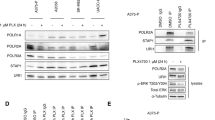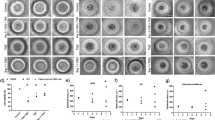Abstract
Mechanisms underlying radiation and chemotherapy resistance, the hallmark of human melanoma, are not well understood. Here we demonstrate that expression levels of signal adaptor protein TRAF2 coincide with melanoma resistance to UV-irradiation. Altered TRAF2 signaling by a form of TRAF2, which lacks the ring finger domain (TRAF2ΔN), increases activities of p38 MAPK, ATF2, and the level of TNFα expression. Forced expression of TRAF2ΔN in HHMSX highly metastatic melanoma cells that lack Fas expression and thus utilize the TNFα-TNFR1 as the major apoptotic pathway sensitized cells to UV-induced apoptosis. An over twofold increase in degree of apoptosis was observed in TRAF2ΔN expressing cells that were treated with actinomycin D, anisomycin or with the radiomimetic drug neocarzinostatin. Sensitization by TRAF2ΔN is selective since it was not observed in response to either Taxol or cis-platinum treatment. TRAF2ΔN effects are primarily mediated via p38 since inhibition of p38 reduces, whereas activation of p38 promotes the level of UV-induced apoptosis. Conversely, activation of IKK attenuates the sensitization of melanoma by TRAF2ΔN, indicating that p38-mediated suppression of NF-κB activity is among TRAF2ΔN effects. Our finding identifies p38, TNFα and NF-κB among key players that efficiently sensitizes melanoma cells to UV-, ribotoxic (anisomycin) and radiomimetic chemicals-induced programmed cell death in response to aberrant TRAF2 signaling.
This is a preview of subscription content, access via your institution
Access options
Subscribe to this journal
Receive 50 print issues and online access
$259.00 per year
only $5.18 per issue
Buy this article
- Purchase on Springer Link
- Instant access to full article PDF
Prices may be subject to local taxes which are calculated during checkout






Similar content being viewed by others
Abbreviations
- AP1:
-
activator protein-1
- ATF2:
-
activating transcription factor 2
- NF-κB:
-
nuclear factor kappa B
- IKK:
-
inhibitor nuclear factor kappa B kinase
- PI:
-
propidium iodide
- TNFα:
-
tumor necrosis factor alpha
- TNFR:
-
tumor necrosis factor receptor
- TRAF2:
-
tumor necrosis factor receptor associated factor 2
- GFP:
-
green fluorescent protein
- IκB:
-
inhibitor NF-κB
- MAPK:
-
mitogen-activated protein kinase
- MFI:
-
medium fluorescence intensity
- MKK:
-
MAPK kinase
- CHX:
-
cycloheximide
- NCS:
-
neocarzinostatin
References
Arch RH, Gedrich RW, Thompson CB . 1998 Genes Dev. 12: 2821–2830
Ashkenazi A, Dixit VM . 1998 Science 281: 1305–1308
Bakker TR, Reed D, Renno T, Jongeneel CV . 1999 Int. J. Cancer 80: 320–323
Deak JC, Cross JV, Lewis M, Qian Y, Parrott LA, Distelhorst CW, Templeton DJ . 1998 Proc. Natl. Acad. Sci. USA 95: 5595–6000
Deveraux Q, Reed JC . 1999 Genes Dev. 13: 239–252
Faris M, Latinis KM, Kempiak SJ, Koretzky GA, Nel A . 1998 Mol. Cell. Biol. 18: 5414–5424
Fuchs SY, Adler V, Pincus MR, Ronai Z . 1998 Proc. Natl. Acad. Sci. USA 95: 10541–10546
Fuchs SY, Chen A, Xiong Y, Pan ZQ, Ronai Z . 1999 Oncogene 18: 2039–2046
Galibert L, Tometsko ME, Anderson DM, Cosman D, Dougall WC . 1998 J. Biol. Chem. 273: 34120–34127
Goillot E, Raingeaud J, Ranger A, Tepper RI, Davis RJ, Harlow E, Sanchez I . 1997 Proc. Natl. Acad. Sci. USA 94: 3302–3307
Hsu H, Shu HB, Pan MG, Goeddel DV . 1996 Cell 84: 299–308
Ip YT, Davis RJ . 1998 Curr. Opinions Cell Biol. 10: 205–219
Ivanov VN, Ronai Z . 1999 J. Biol. Chem. 274: 14079–14089
Ivanov VN, Ronai Z . 2000 Oncogene 19: 3003–3012
Ivanov VN, Kherl JH, Ronai Z . 2000 Oncogene 19: 933–942
Kasibhatla S, Brunner T, Genestier L, Echeverri F, Mahboubi A, Green DR . 1998 Mol. Cell 1: 551
Kelliher MA, Grimm S, Ishida Y, Kuo F, Stanger BZ, Leder P . 1998 Immunity 8: 297–303
Krammer PH . 2000 Nature 407: 789–795
Lin, X, Mu Y, Cunningham ET, Marcu KB, Geleziunas R, Greene WC . 1998 Mol. Cell Biol. 18: 5899–5907
Liu ZG, Hsu H, Goeddel DV, Karin M . 1996 Cell 87: 565–576
Malinin NL, Boldin MP, Kovalenko AV, Wallach D . 1997 Nature 385: 540–544
Maniatis T . 1999 Genes Dev. 13: 505–510
Meier F, Satyamoorthy K, Nesbit M, Hsu MY, Schittek B, Garbe C, Herlyn M . 1998 Bioscience 3: d1005–d1010
Minden A, Karin M . 1997 Biochim. Biophys. Acta. 1333: F85–F104
Moretti S, Pinzi C, Spallazani A, Berti E, Chiarugi A, Mazzoli S, Fabiani M, Vallecchi C, Herlyn M . 1999 Int. J. Cancer 20: 160–168
Nagata S . 1997 Cell 88: 355–365
Natoli G, Costanzo A, Ianni A, Templeton DJ, Woodgett JR, Balsano C, Levrero M . 1997 Science 275: 200–203
Nicoletti I, Migliorati G, Pagliacci MC, Grignani F, Riccardi C . 1991 J. Immunol. Methods 139: 271–279
Nishitoh H, Saitoh M, Mochida Y, Takeda K, Nakano H, Rothe M, Miyazono K, Ichijo H . 1998 Mol. Cell 2: 389–395
Peixoto JG, Andreo P . 2000 Phys. Med. Biol. 45: 563–575
Peli J, Schroter M, Rudaz C, Hahne M, Meyer C, Reichmann E, Tschopp J . 1999 EMBO J. 18: 1824–1831
Relaix F, Wei XJ, Wu X, Sassoon DA . 1998 Nature Genetics 18: 287–291
Rhoades KL, Golub SH, Economou JS . 1992 J. Biol. Chem. 267: 22102–22107
Ronai Z, Yang YM, Fuchs SY, Adler V, Sardana M, Herlyn M . 1998 Oncogene 16: 523–531
Ruller S, Stahl C, Kohler G, Eickhoff B, Breder J, Schlaak M, van der Bosch J . 1999 Clin. Cancer Res. 10: 2714–2725
Song HY, Regnier CH, Kirschning CJ, Goeddel DV, Rothe M . 1997 Proc. Natl. Acad. Sci. USA 94: 9792–9796
Tan P, Fuchs SY, Chen A, Wu K, Gomez C, Ronai Z, Pan ZQ . 1999 Mol. Cell 3: 527–533
Tobin D, van Hogerlinden M, Toftgard R . 1998 Proc. Natl. Acad. Sci. USA 95: 565–569
Tyers M, Jorgensen P . 2000 Curr. Opin. Genet. Dev. in press
Tyers M, Willams AR . 1999 Science 284: 603–604
van Dam H, Huguier S, Kooistra K, Baguet J, Vial E, van der Eb AJ, Herrlich P, Angel P, Castellazzi M . 1998 Genes Dev. 12: 1227–1239
Yang X, Khosravi-Far R, Chang HY, Baltimore D . 1997 Cell 89: 1067–1076
Yang YM, Dolan L, Ronai Z . 1996 Oncogene 12: 2223–2233
Yeh WC, Shahinian A, Speiser D, Kraunus J, Billia F, Wakeham A, de la Pompa JL, Ferrick D, Hum B, Iscove N, Ohashi P, Rothe M, Goeddel DV, Mak TW . 1997 Immunity 7: 715–725
Yuasa T, Ohno S, Kehrl JH, Kyriakis JM . 1998 J. Biol. Chem. 273: 22681–22692
Zandi E, Rothwarf DM, Delhase M, Hayakawa M, Karin M . 1997 Cell 91: 243–252
Acknowledgements
We thank Drs H van Dam, JS Economou, M Karin and R Davis for providing expression vectors and Dr M Herlyn for LU1205 and WM1552 melanoma cells. Support from the National Cancer Institute through grant CA 51995 (to Z Ronai) is gratefully acknowledged.
Author information
Authors and Affiliations
Rights and permissions
About this article
Cite this article
Ivanov, V., Fodstad, Ø. & Ronai, Z. Expression of ring finger-deleted TRAF2 sensitizes metastatic melanoma cells to apoptosis via up-regulation of p38, TNFα and suppression of NF-κB activities. Oncogene 20, 2243–2253 (2001). https://doi.org/10.1038/sj.onc.1204314
Received:
Revised:
Accepted:
Issue Date:
DOI: https://doi.org/10.1038/sj.onc.1204314
Keywords
This article is cited by
-
ATM-NFκB axis-driven TIGAR regulates sensitivity of glioma cells to radiomimetics in the presence of TNFα
Cell Death & Disease (2013)
-
Overload of the heat-shock protein H11/HspB8 triggers melanoma cell apoptosis through activation of transforming growth factor-β-activated kinase 1
Oncogene (2007)
-
Role of nuclear factor-κ B in melanoma
Cancer and Metastasis Reviews (2005)
-
De-regulation of ubiquitin-dependent proteolysis and the pathogenesis of malignant melanoma
Cancer and Metastasis Reviews (2005)
-
Apoptosis and melanoma chemoresistance
Oncogene (2003)



